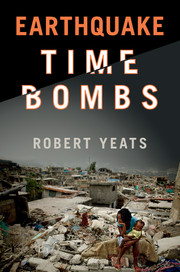Book contents
- Frontmatter
- Contents
- Acknowledgments
- Why this book?
- PART I EARTHQUAKES, DEEP TIME, AND THE POPULATION EXPLOSION
- 1 Plate tectonics and why we have earthquakes
- 2 An earthquake primer
- 3 Deep time
- 4 When's the next Big One?
- 5 Population explosion and increased earthquake risk to megacities
- PART II EARTHQUAKE TIME BOMBS
- PART III SUMMARY AND RECOMMENDATIONS
- References
- Index
2 - An earthquake primer
from PART I - EARTHQUAKES, DEEP TIME, AND THE POPULATION EXPLOSION
Published online by Cambridge University Press: 05 November 2015
- Frontmatter
- Contents
- Acknowledgments
- Why this book?
- PART I EARTHQUAKES, DEEP TIME, AND THE POPULATION EXPLOSION
- 1 Plate tectonics and why we have earthquakes
- 2 An earthquake primer
- 3 Deep time
- 4 When's the next Big One?
- 5 Population explosion and increased earthquake risk to megacities
- PART II EARTHQUAKE TIME BOMBS
- PART III SUMMARY AND RECOMMENDATIONS
- References
- Index
Summary
INTRODUCTION
The preceding chapter shows why we have earthquakes. They are a product of plate tectonics, in which parts of the Earth's crust move with respect to adjacent parts due to slow convection in the underlying mantle (Figure 1.2, lower diagram). The present chapter presents a brief summary of how we describe earthquakes, including terms like magnitude and intensity, defined below.
An earthquake happens when two sections of crust, in some cases at a tectonic plate boundary, become so stressed that the strength of the rock is exceeded, generating an earthquake as the masses of rock on opposite sides of a zone of weakness suddenly shift past each other. Some part of the crust might be weaker than other parts, and so the earthquake breaks along this weaker zone. In this respect, the Earth behaves like a poorly constructed building, which is subject to collapse because of failure of its weakest part. This is likely to be a fault, a zone of weakness that has ruptured before, and ruptures again, accompanied by an earthquake.
The Earth's crust is elastic, that is, it bends when it is stressed, and the bend goes back to its original shape when the stress is removed. One example is the ocean crust near the Hawaiian Islands, which is bowed downward by the massive weight of Hawaiian volcanoes, the way your bed would behave if a very heavy individual lay down on it. When your heavy friend gets off the bed, it should return to its earlier shape, if it has good springs.
As two plates move toward each other in a subduction zone, the upper plate is slowly bowed downward elastically, like a diving board, until the strength of the subduction zone at the plate boundary is exceeded, producing an earthquake (Figure 1.4, upper diagram). When that happens to a subduction zone that is underwater, the upper plate that has been bowed downward snaps back. In this comparison, the Earth's crust is like a diving board, except that it is underwater. When the diver jumps off, the board rebounds to its position before the diver walked out on it. As the Earth's crust rebounds beneath the sea, it suddenly pushes upward all the seawater on top of it, producing a tsunami.
- Type
- Chapter
- Information
- Earthquake Time Bombs , pp. 25 - 33Publisher: Cambridge University PressPrint publication year: 2015



